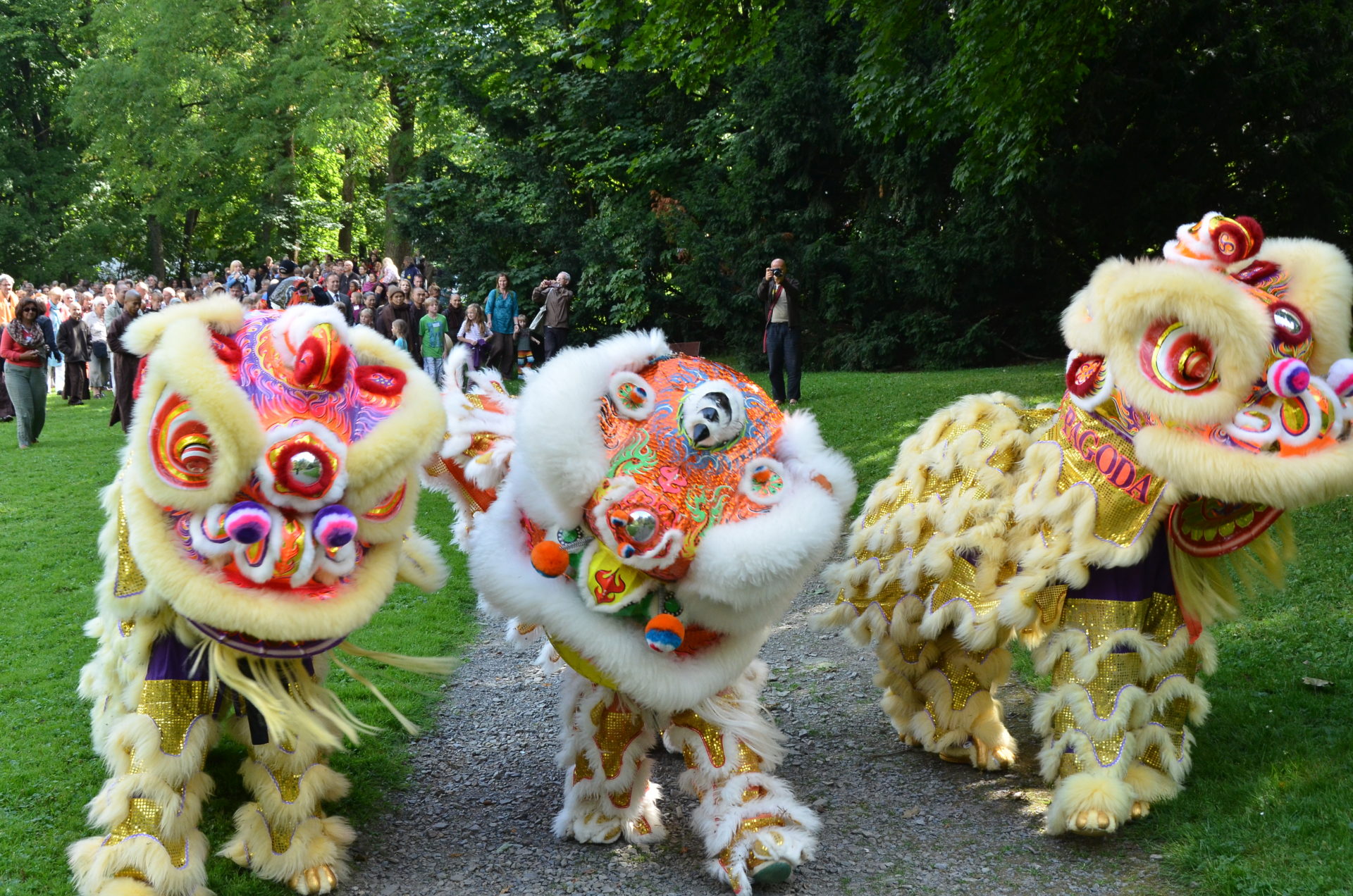By Brother Chan Phap Nguyen
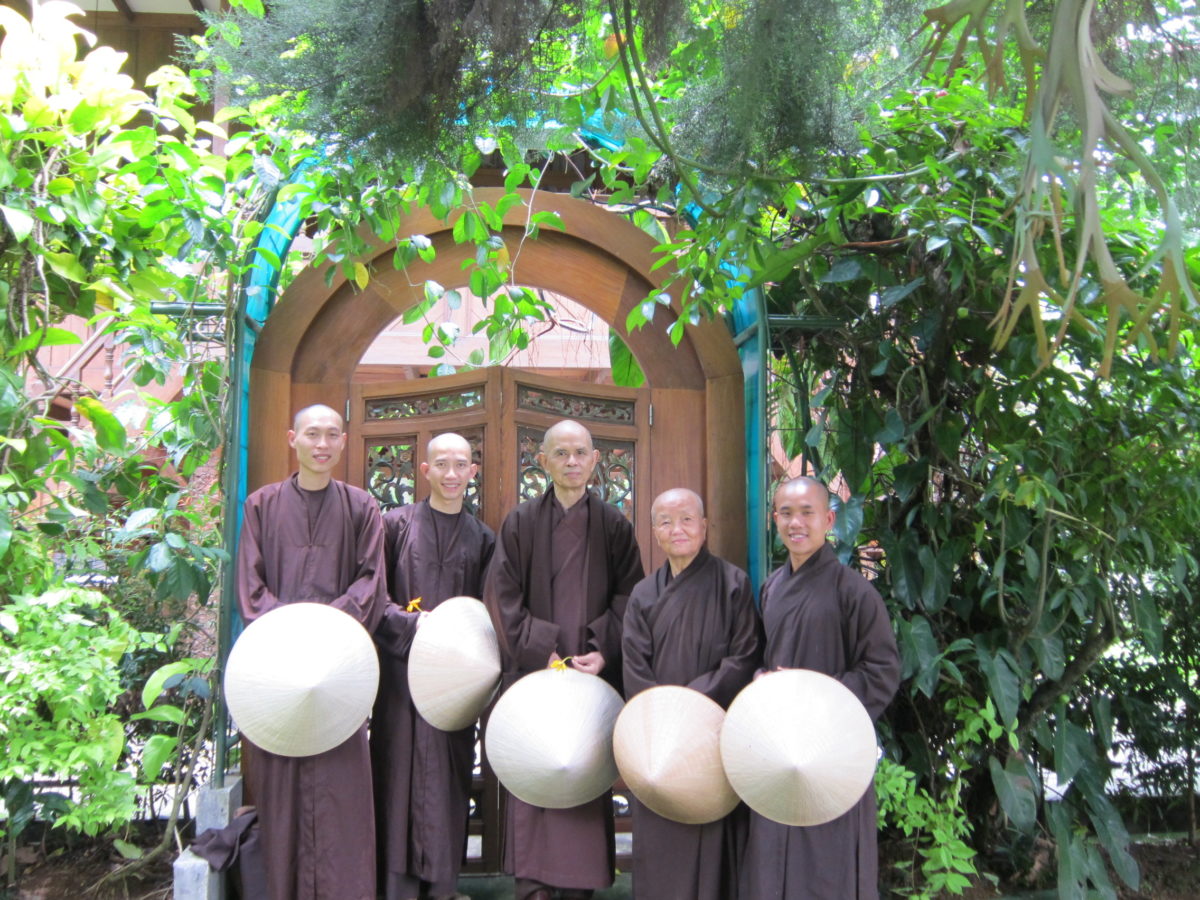
The Plum Village Mindfulness Practice Center was established in 1982. Over the years, practice centers have been founded around the world in response to an increasing need from practitioners in many countries. These centers include Deer Park Monastery in California,
By Brother Chan Phap Nguyen

The Plum Village Mindfulness Practice Center was established in 1982. Over the years, practice centers have been founded around the world in response to an increasing need from practitioners in many countries. These centers include Deer Park Monastery in California, Blue Cliff Monastery in New York, Magnolia Grove Monastery in Mississippi, Entering the Stream Meditation Center in Australia, Plum Village International Meditation Center in Thailand, the Asian Institute of Applied Buddhism in Hong Kong, and the European Institute of Applied Buddhism in Germany. All practice meditation according to the Plum Village tradition.
Challenging Times
In its infancy, Plum Village encountered many infrastructure difficulties. Most of the hamlets were purchased from farmers who raised cattle and sheep, and they lacked electricity and heating systems. Winter at Plum Village was extremely cold, and brothers and sisters had to bring their own blankets to cover themselves during sitting meditation. When Thay wrote his books, one hand held the pen while the other hand warmed over the fire. Water, equipment, utensils, and food were limited. As the number of practitioners at Plum Village increased, it became apparent the infrastructure needed to expand. When Lower Hamlet could not meet the requirements for operating a public center, it was closed down. This has also happened to Upper Hamlet and New Hamlet.
During these years, there were many times when Thay fell ill, and it was uncertain he would recover. Thanks to the support of the Buddha and patriarchs, Thay pulled through. In addition to the physical difficulties, the Sangha also experienced spiritual challenges. The 2009 tragedy at Prajna Monastery in Vietnam was a period of deep difficulty for Plum Village. So much suffering and fear poured on those young, innocent monks and nuns who no longer could take refuge in their own motherland and had to seek refuge across the globe. Fortunately, with the support of the Buddha and ancestors, brothers and sisters adhered to the practice of nonviolence and were able to overcome that painful time.
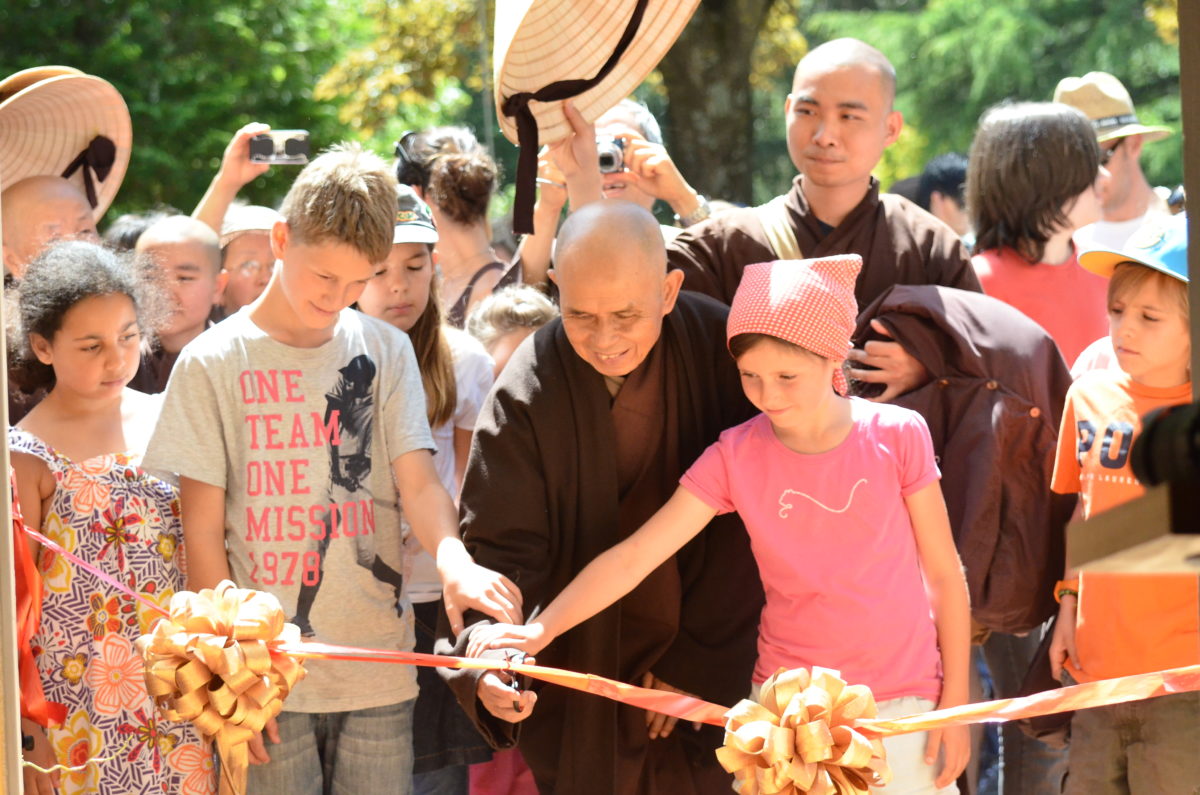
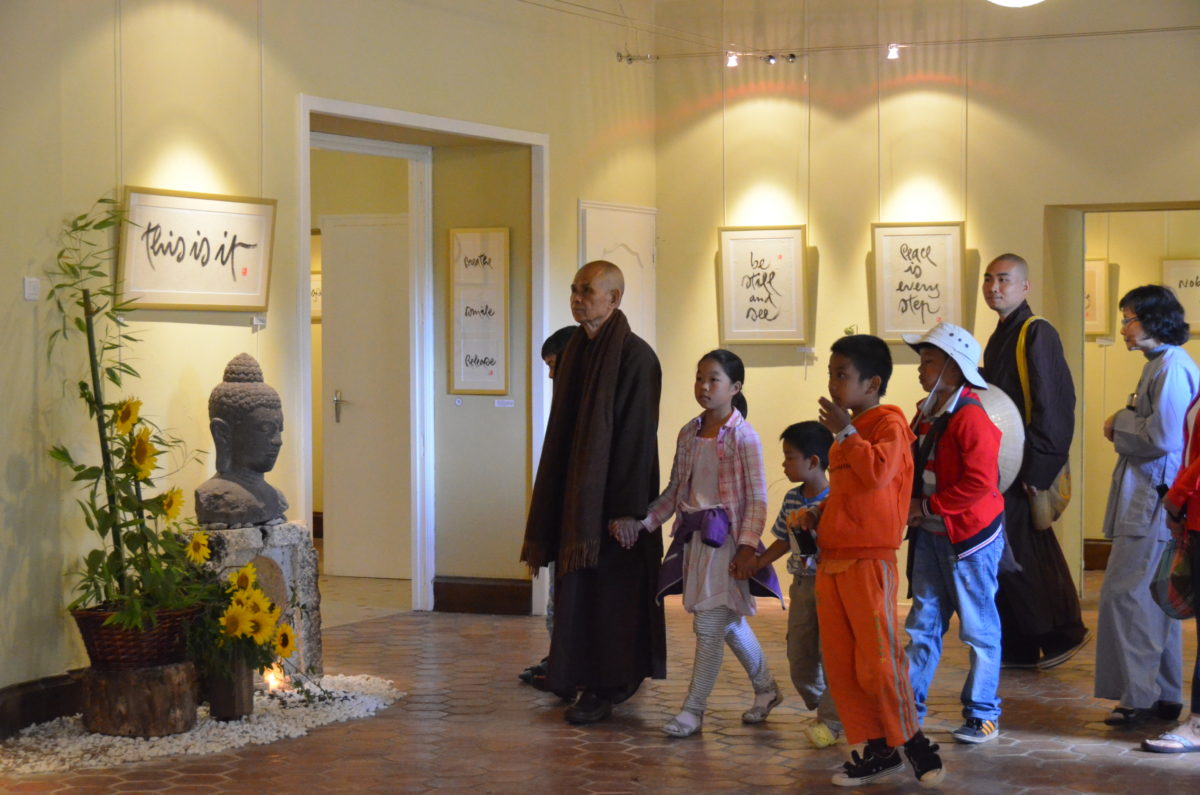
Plum Village Anniversary
At the start of the 2011-2012 Winter Retreat, during a monastic day at the Hermitage, Thay and his students sat together around a glowing fire. Thay said, “Next year is the thirtieth anniversary of Plum Village and we will celebrate the whole year. We can organize in such a way that we celebrate in every retreat. If we practice to generate happiness in every day, we don’t need to celebrate in a grand and luxurious fashion in order to be happy. We only need to be happy with what we are doing in our daily life, right in this present moment. That is truly to celebrate.”
Following Thay’s suggestion, we organized six working groups to focus on celebrating this anniversary. The groups presented the history of Plum Village, set up an exhibition of Thay’s calligraphy, exhibited the Dharma tools Thay often uses while teaching, prepared an exhibition of Thay’s books, worked on Plum Village’s annual Vietnamese magazine, and organized performances. The hamlets were filled with enthusiastic and joyful discussions, which were enough to bring us happiness each day.
Over the next three months, we prepared to celebrate thirty years of Plum Village. The first exhibition took place at the end of March 2012, during the French retreat. We organized in a way that allowed everyone to fully participate in each Day of Mindfulness, as well as in two daily sessions of sitting meditation and chanting. Our free time was used to renovate, repair, and clean the hamlet. Nearly all the tasks were completed by the brothers and sisters on the organizing team. A few brothers and sisters volunteered to sing and play the guitar while we worked, adding an atmosphere of lightness and joy to our tasks. I prepared sweet soup for all the brothers to enjoy during break, and we would sit around the pot, enjoying the soup and stories that brought much laughter. One brother said, “People can earn a lot of money in their jobs, but do they have such light and happy moments like we are enjoying now?” At Plum Village, our salary is the happiness of lay friends who come to practice with us, and our nourishment is the brotherhood and sisterhood.
The thirty-year anniversary ceremony was celebrated twice during the Summer Opening. After a Dharma talk at Upper Hamlet, Thay lead the Sangha in walking meditation to Son Ha (Foot of the Mountain Temple), where we held the first ceremony. The path from Upper Hamlet to Son Ha passes through a valley of pine trees, which became more beautiful when decorated with pots of flowers to welcome Thay and the Sangha. Thay’s calligraphy—“I have arrived, I am home”—was displayed below the pots in eight different languages. One venerable from China said, “I really like the way brothers and sisters decorate. It is simple, but I can feel there is much love. It is very beautiful and Zen.”
On the grass lawn in front of Son Ha Temple, the Sangha enjoyed classical music performed by our Western brothers and sisters, as well as the lion dance performed by our Vietnamese brothers with the beat of the drums. After the lion dance and a few introductory words about Plum Village and the calligraphy exhibition, Thay was invited to cut the inauguration banner and lead the Sangha into the exhibition.
The second exhibition was organized at New Hamlet. The lion dance also welcomed the Sangha, and the sisters from both New Hamlet and Lower Hamlet gave a musical/dance performance. Everyone then enjoyed some anniversary cake, and Thay opened the exhibition on his Dharma tools and books.
In an opening speech for the calligraphy exhibition, we shared that it has taken us thirty years to come this far. Some people were very touched by this, because thirty years is a relatively long time for such humble development in terms of infrastructure. They could begin to understand how much simpler and more difficult life at Plum Village must have been years ago. Yet Plum Village does not aim to develop monumental buildings, but focuses on the practices so that it can benefit people all around the world.
The year 2012 marked thirty years of Plum Village, which is neither a short nor a long time. Confucius said, “By the age of thirty, one can be independent.” In other words, when he reached the age of thirty, he was able to stand on his own two feet. Looking back at our history, we dare not be so self-assured, as Plum Village is still very young. As children of the Buddha, we are aware that we should not just work and neglect our practice. We have to make full use of our time to develop our bodhicitta, so that we can grow and turn the Dharma wheel further. This is truly to repay the four debts of gratitude and grow up on our path of practice.
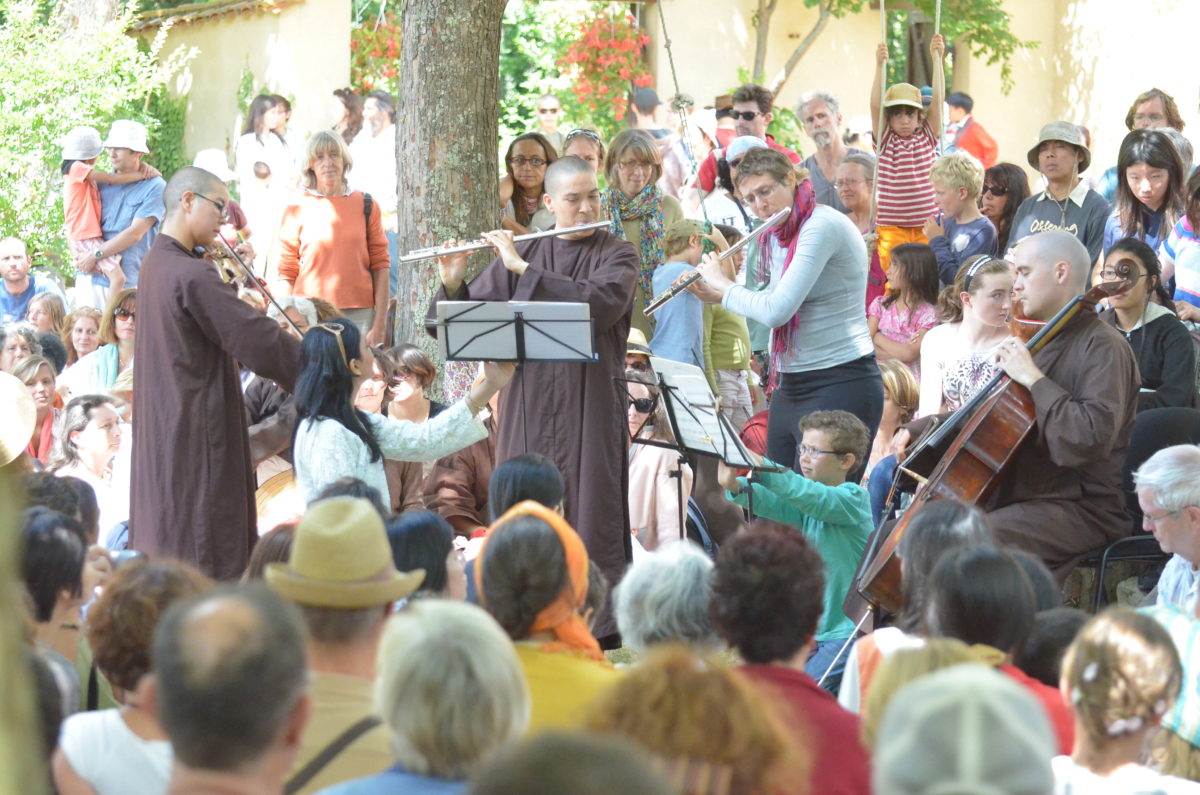
Integrating Buddhism into Daily Life
To organize and lead retreats with the intention of integrating Buddhism into daily life is part of our service. Plum Village is open year-round to welcome retreatants from all over the world to practice. Each year, Plum Village offers three or four large retreats, with seven hundred to one thousand participants. Additionally, Thay and Plum Village Dharma teachers lead teaching tours in many countries. In odd-numbered years, Thay and the Plum Village delegation go on a three-month teaching tour in North America and/or Asia. In even-numbered years, Thay goes on a teaching tour in Europe. The Dharma teachers also lead retreats in the spring and autumn. Over the past thirty years, Plum Village has helped people around the world heal their wounds, transform their suffering, reconcile and re-establish communication with loved ones.
At a retreat in Rome, Italy, last autumn, a blind lady shared, “In the 1990s I discovered there was something wrong with my eyes and I could no longer see clearly. I was told that I would become blind within a few years. When I returned home and told my mother, she said it was a hereditary condition. I was very sad knowing I would be blind without a cure. Within the next few years, the state of my eyesight progressively worsened until I was considered blind. I suffered greatly with my condition, and wanted to return to a more spiritual life in order to learn how to live peacefully and harmoniously with this disability. In 1992, I was told that a Vietnamese Buddhist monk was visiting Rome to teach. I found my way to the teaching venue of Thay Thich Nhat Hanh. The first time I heard Thay’s voice I knew he would be my teacher. Thay’s voice is gentle, expressive, and full of compassion. I was so happy! At the retreat I learned how to practice mindfulness and was guided in living mindfully every moment. I learned to breathe and walk in mindfulness, learned ways to reduce tension in my body and calm my mind. Thanks to the practices of mindfulness, I was able to take care of myself in the basic things of my daily life. Even though I can no longer see Thay’s face, I recognize my teacher when I hear that gentle and compassionate voice. I am ever so grateful because he helped me to find myself in a period of life that was full of darkness.” Everyone was very moved by her sharing.
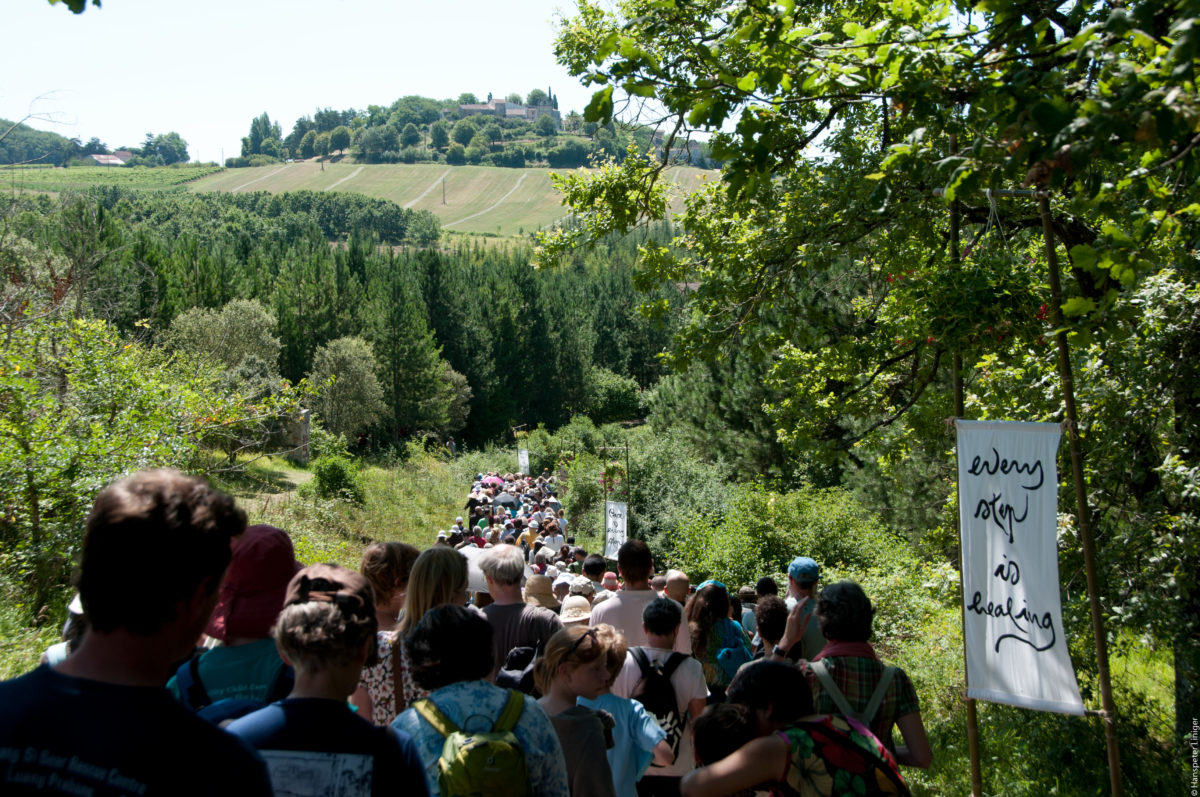
Transporting Buddhism into the Future
Today, globalization has brought people more tension, pressure, worries, competition, and violence. In this world, people need a spiritual dimension to their lives more than ever. At Plum Village, we are always enthusiastic about creating fresh, joyful, and gentle methods of practice that will encourage young people to come and practice. Young people are open-minded and creative, with a high capacity to learn. They have strong life energy, a revolutionary spirit, and a huge “fire” of love and aspiration to serve (bodhicitta).
Thay and the Sangha always encourage and support the young monastic brothers and sisters to discover their talents and potential skills. These young monastics practice to transform themselves as well as to be role models and help lay friends to overcome their difficulties. Young monastics are the future and the continuation of the Buddha, of our teacher and spiritual ancestors. They transport Buddhism into the future. Thay has ordained more than eight hundred monastic disciples. Aside from these brothers and sisters, Plum Village also has “golden eggs,” commonly referred to at Plum Village as the “Fragrant Tea Tree” ordination family, with monastics from other Buddhist traditions or temples who have joined the Sangha. The number of monastics in this family has grown to one hundred brothers and sisters, and their presence has enriched Plum Village. Within our Sangha of nine hundred monastics practicing at Plum Village centers (in France and other countries), we have brothers and sisters of twenty-eight different nationalities.
In 2008, many young people attended the retreat in Italy. Aside from the retreat, we also organized a presentation and activities for about five hundred high school students near Rome. During Dharma discussion, we listened deeply to the young people as they shared the difficulties and blockages in their lives. Many felt lonely and alienated with no sense of life direction. Others carried deep wounds and suffering from their family and society. They didn’t believe in themselves and were unable to trust others around them. They were carried away by feelings and emotions, and consequently, their speech and actions were not wholesome.
Thay suggested we initiate a movement especially for young people. The Wake Up movement builds a healthy and compassionate society based on the Five Mindfulness Trainings. It is a source of spiritual nourishment, a playing field especially for young people who seek to direct themselves towards a globalized spiritual ethic.
The Wake Up movement has become very popular, and each year Plum Village organizes several retreats specifically for this movement. Led by young Dharma teachers, these retreats take place around the world. At Trafalgar Square in London in 2012, nearly five thousand young people gathered to sit in meditation and listen to a Dharma talk given by Thay. This movement transcends all religious and national boundaries, inviting everyone to participate in activities that are refreshing, joyful, wholesome, and relevant to the youth of today. In many of the world’s major cities, Sanghas of young people participate in Wake Up activities. As a result, we have created a Wake Up website (www.wkup. org) where people can follow the latest news, practice together, share, and contact each other. The Wake Up movement not only encourages activities that are meaningful and create happiness, but also offers a wholesome context that connects young people from all over the world.
Plum Village has continued to develop methods for practicing mindfulness in ways that are most relevant and useful to modern people. Our Applied Ethics Program aims to integrate mindfulness practices into the education sector. Based on the Five Mindfulness Trainings, this program would be taught as part of the regular curriculum, with mindfulness being the method to put it into practice. Teachers of this subject must know how to practice mindfulness with happiness in order to be able to teach it to students. At Plum Village, we have a new program to train such teachers, and we have organized training programs for educators in many countries, including India, the U.S., Thailand, Bhutan, France, and Germany. At a retreat for American congressmen/women in Washington, D.C., in 2011, and at a lecture in the House of Lords in England in 2012, Thay addressed the issue of how to integrate the Applied Ethics Program into the education sector.
During the 2011 U.S. teaching tour, Thay and a number of brothers and sisters met with Jerry Brown, the governor of California. During that meeting, we addressed how to integrate the Applied Ethics program into California’s education system. Governor Brown welcomed the proposal, saying, “Currently, I manage two private schools, and we can try and apply this program in my two schools first.” During the U.S. tour, Thay also met with Senator Tim Ryan from Ohio and Maryland Governor Martin O’Malley to discuss the program.
Monastic Life at Plum Village
Individuals with the aspiration to serve and to practice a monastic life of chastity may enter the five-year monastic program at Plum Village. After five years, these individuals may take monastic vows for the rest of their lives, or they can return to lay life and continue to practice as lay Dharma teachers. To join this program, individuals must be under thirty-five years old and have the aspiration to serve and to practice the life of a monastic. The program allows young people to serve in ways that are similar to serving in the army. Yet our true enemies are the “ghosts” of afflictions, like anger, hatred, violence, craving, jealousy, and discrimination. Young people learn the practices of mindfulness in order to recognize, embrace, and transform these ghosts. When we can embrace and transform these ghosts, we experience happiness and freedom. If we practice with good results, we can help our loved ones, society, country, and world become more peaceful and wholesome.
The “brown robe” family, our fourfold Sangha, is comprised of monastic brothers and sisters in brown robes, and laymen and laywomen in the Order of Interbeing. We are all active in teaching and in social aid/relief programs around the world. Created by Thay in 1966, the Order of Interbeing has grown from six to more than one thousand members who practice according to the Fourteen Mindfulness Trainings. These disguised bodhisattvas go into the world to rescue beings. The Understanding and Love Program in Vietnam and India includes more than three hundred kindergartens, operated by these Order of Interbeing bodhisattvas who invest much of their time and energy in developing and serving. Without these bodhisattvas, we cannot give poor children a glass of milk and a meal for lunch.
The brown-robed bodhisattvas of the Order of Interbeing in countries like France, England, Holland, Italy, Thailand, Malaysia, Hong Kong, Indonesia, Brazil, and Canada, all use skillful means to help Plum Village in its work to rescue all beings. Some translate Thay’s books; others help to print and publish his books or translate audio Dharma talks. Some compose music; others teach mindfulness in prisons; still others help to organize retreats. Additionally, some help with financial and administrative work, while others assist with fundraising or provide legal assistance. Each person is a precious jewel of the Sangha, and we are always grateful for each person’s dedication and presence.
Today there are many active Sanghas practicing according to the tradition of Plum Village, with most located in major cities around the world. Among the one thousand practicing Sanghas, eighty are in the UK, seventy are located in Germany, and more than five hundred are in the U.S. As the scope of our spiritual work is very expansive and not limited to France or Vietnam, we have always done the important work of a gardener (a monastic), to help people tend to the “garden of their heart” and to sow wholesome seeds. Through the rise of so many Sanghas, we see that those seeds have germinated and are now sprouting up everywhere.
The Continuation of Buddha
Over the past thirty years, the Plum Village Sangha boat has weathered many storms and challenges and has delivered many people to the shores of freedom, peace, and happiness. Thay is a solid captain, directing us in navigating the Sangha boat. His wisdom is like a great, ancient tree that continues to flower and produce fruits—an ancient tree in whom we can all take refuge.
We are very grateful to all those who have contributed to creating Plum Village, and to our predecessors who built and developed the Sangha. Stepping onto Upper Hamlet, we can see the shadows and the continuation of Brother Nguyen Hai in Brother Phap Huu, Brother Phap Trien, and many others. Arriving at Deer Park Monastery, we can see the continuation of Brother Giac Thanh in Brother Phap Dung, Brother Phap Hai, Brother Phap Ho, and many other brothers and sisters. When we think of the social relief program, we can also see the continuation of Brother Thanh Van and Sister Chan Khong through Ms. Xuan, Mr. Nghiem, Mr. Dinh, and many other people in the world.
As the younger generation, we are always indebted to our respected Thay, who has given his whole life for the benefit of all beings. Although advancing in age, he never ceases to renew the practices so that they remain relevant and appropriate to the times, especially for future generations seeking to take refuge.
Each of us is a cell in the Sangha body, a member of the Sangha boat. In a body, there are millions of cells. Each cell has its own function. Similarly, with the Sangha boat, we are the wooden planks, the nails, the boat captain. We are the boat. The planks have the function of keeping the water out of the boat, the nails keep the planks together, the captain navigates the boat to its destination, and the boat delivers people across the river. Thanks to the combination of these components working together, we have a solid boat to bring people to the other shore. In the same way, to continue the path of the Buddha is the duty and the collective expedition of the ancestors, of Thay and the Sangha, of all of us together. Each person gives a hand to the career of the Buddha, like one hand carries on from another hand.
Reviewing the past thirty years, we are ever so grateful for the support of the Buddha and ancestors. We are clearly aware that life is impermanent. Any doctrine, any country, any tradition will one day decline because waxing and waning is a never-ending process. But we vow to continue learning and practicing, to take more steps in freedom and solidity in order to offer another thirty years. Thay teaches us, “The first thirty years can go by slowly, but the next thirty years will pass very quickly.” Together, hand in hand with Thay, we can go as a river to climb the hill of the century. It is not a matter of time, be it thirty years or three hundred years, but we have to go in such a way that every minute can bring happiness, peace, and benefit for ourselves and for others. In doing so we can enjoy the inheritance and truly continue the career of the Buddha.
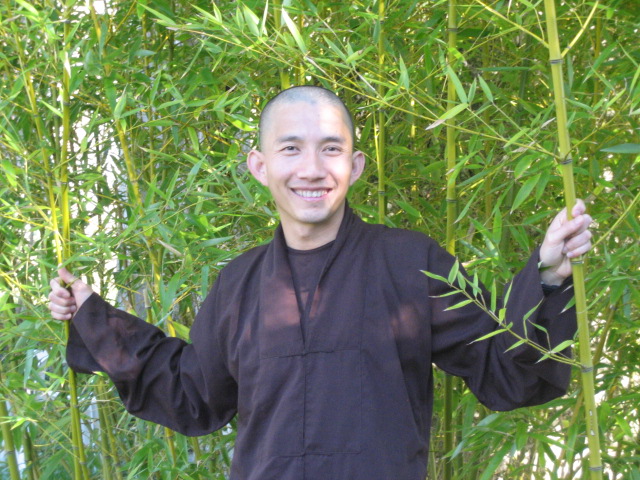
Brother Chan Phap Nguyen, born and raised in Vietnam, immigrated to the U.S. with his family at age thirteen. He became a monk in February 2008 and has lived in Plum Village ever since. He enjoys drinking tea and lying on a hammock.

